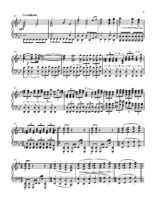When I was a kid, I could read music. I could sight read pretty well actually, playing either the  piano or the flute. Back in the day, if you had handed me a piece of sheet music, I would have quite confidently played the piece. But today? Ha! Not a chance. Today, I would puzzle through each note, figuring out what it is, its time value and whatever dynamics might be indicated. Is it a flat? Is it a sharp? And where the heck is that note on my instrument? I had the skills, once. But as I got older, I didn’t play as often. I lost any fluency I might have had. These days, I don’t do much more than noodle on the piano, and I don’t think I’ve picked up a flute since I was 18! I guess it’s not surprising that I can’t really read music any more.
piano or the flute. Back in the day, if you had handed me a piece of sheet music, I would have quite confidently played the piece. But today? Ha! Not a chance. Today, I would puzzle through each note, figuring out what it is, its time value and whatever dynamics might be indicated. Is it a flat? Is it a sharp? And where the heck is that note on my instrument? I had the skills, once. But as I got older, I didn’t play as often. I lost any fluency I might have had. These days, I don’t do much more than noodle on the piano, and I don’t think I’ve picked up a flute since I was 18! I guess it’s not surprising that I can’t really read music any more.
When you don’t use a skill, eventually, you lose it. That’s a pretty universal truth. Why, then, do many people assume that they will maintain basic physical skills if they don’t move their bodies on a regular basis? Life is busy, I get it. And once you learn how to walk or ride a bike, you never forget, right? Isn’t that the old saying… “it’s just like riding a bike?”
How often in your DAILY life, do you do things that require you to reach over your head, and maybe even handle something heavy while you’re up there? How often, in your DAILY life, do you do things that require you to balance? How often, in your DAILY life, do you do things that require you to twist your body (and by that I mean more than just a shoulder check or two while driving)? How often would you have to move in a way that combines these? My guess is that the number of times you do this kind of motion every day is relatively low. And for some, not at all. So why be surprised when it’s tough for you to get that box down from the top shelf in the cupboard? Why be surprised when it it’s tricky to keep your balance while walking in the soft sand on the beach? Why be surprised when your back “goes out” when you’re shovelling snow? Or when your neck & shoulders get sore after a run? When you don’t move regularly, your body will have a harder time completing the tasks you ask it to complete. You begin to lose the movement fluency you had as a kid. But not just because you’re getting older. Because you’re not moving as fully as you once did.

Sure, you get out and “exercise.” And that’s great. But if you think about the large majority of exercise programs, the emphasis is typically on fairly intense activity in a relatively limited range of motion. Maybe you’ll look great in a bikini – but your ability to move easily, freely and with confidence in a wide variety of situations will begin to erode. This is especially true when you consider that most people spend hours up on hours every day sitting down at a desk, or in the car, or in front of the TV. Fundamental motor control skills (like integrating core musculature into larger movements) can literally be lost with too much time sitting down. The only way to keep moving well is to KEEP MOVING WELL. And that means moving your body in as many different ways as you can, as often as you can; with varying intensity, speed, direction, load and complexity. You’ve just got to MOVE!
There is, in Canada, a group of movement experts who are making concerted efforts to increase the physical literacy in kids. They are pushing for action NOW. I applaud their efforts. With outdoor play at an all-time low for kids, and with the increasing number of hours most children spend in front of a screen, basic movement literacy skills are being lost to much of a generation. Kids are simply not developing a healthy movement vocabulary that will help them to develop well and move into their futures with ease. We have only the slightest inkling of what the implications of that will be for the future. My guess, though, is that it’s not good.
“Movement vocabulary is the repertoire of movement skills someone has. The more movement vocabulary they have, the more opportunity they have to participate in things. Movement fluency is the ability to execute a component of movement vocabulary with expertise. Physical proficiency refers to the ability to select the right type of movement repertoire and sequence it correctly in a certain environment. Finally, physical literacy is ability to demonstrate multiple proficiencies in many environments.” (1)
We have as much a responsibility to teach our kids the ABC’s of movement as we do to teach them to read, and to write, and to understand numbers. It’s not just about sports. It’s about learning to move well. And that’s true for adults as well. We can’t exactly teach movement literacy if we don’t have it ourselves. Over the years, I’ve worked with a huge number of active, intelligent people who didn’t realize that their aches and pains had a lot more to do with loss of movement fluency than with the effects of aging or any specific injury. With attention and practice, they were able to restore that fluency – and the aches and pains disappeared! You can do it too. It’s time to take back your body and your physical life. Fitness training is only really fitness if it keeps you moving well. When you start losing the ability to move with ease, the world begins to get a whole lot smaller. Help yourself and commit to helping your kids by embodying your movement and learning (or re-learning) to move well.
Here’s my challenge to you. Move, play, explore. Take a kid (or your best friend’s kid) with you. Go for a hike, go boogie boarding at the beach, ride a horse, play volleyball, go skiing or rock climbing. Try something you’ve never done before. Enjoy! Laugh! Fall down! Make it an adventure. Do it again! Try something different. The connections you make – with your body, with your mind and emotions, with your family and friends, with your environment – will give you new life and energy. Your world will expand and you’ll feel better in every aspect of your life. If you’ve reached a point where this idea seems daunting, start small! Go for a walk with a friend, head to your local pool for a swim or try a beginner’s yoga class.
And if, as you play more fully, you find that things aren’t moving as easily as you’d like, give Moving Spirit a call. We specialize in providing personalized movement solutions to get you moving at your best so you can live your life to the fullest. Check out our private and semi-private training movement programs, or come to a workshop!
Movement is like a fountain of youth. It will keep you young in heart, mind and body – and you’ll more than likely have a whole lot of fun in the process. If you’d like to learn more about improving movement literacy in our kids, have a look at this video, and then visit www.physicalliteracy.ca
VIDEO: PHYSICAL LITERACY – ESSENTIAL FOR LIFE
(1) From www.physicalliteracy.ca
